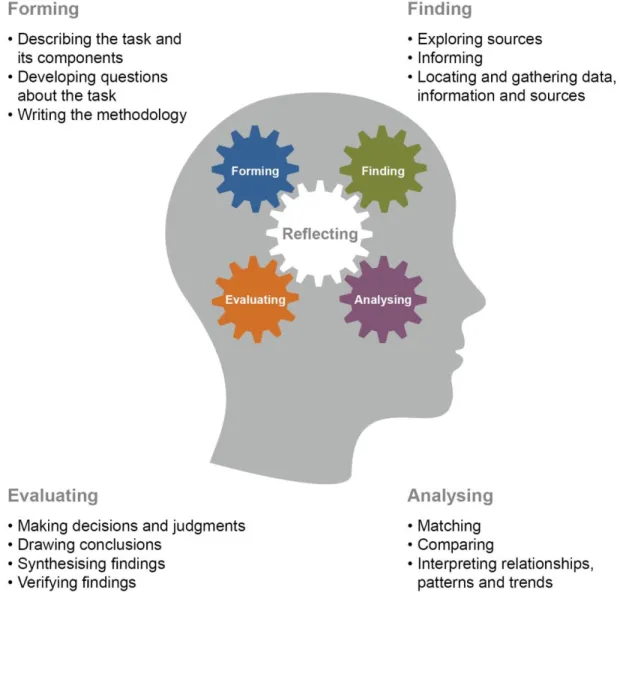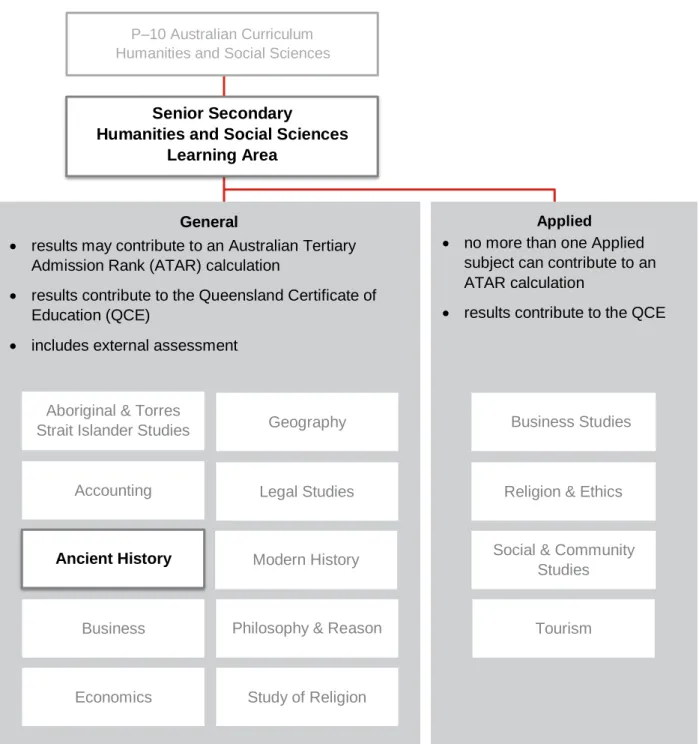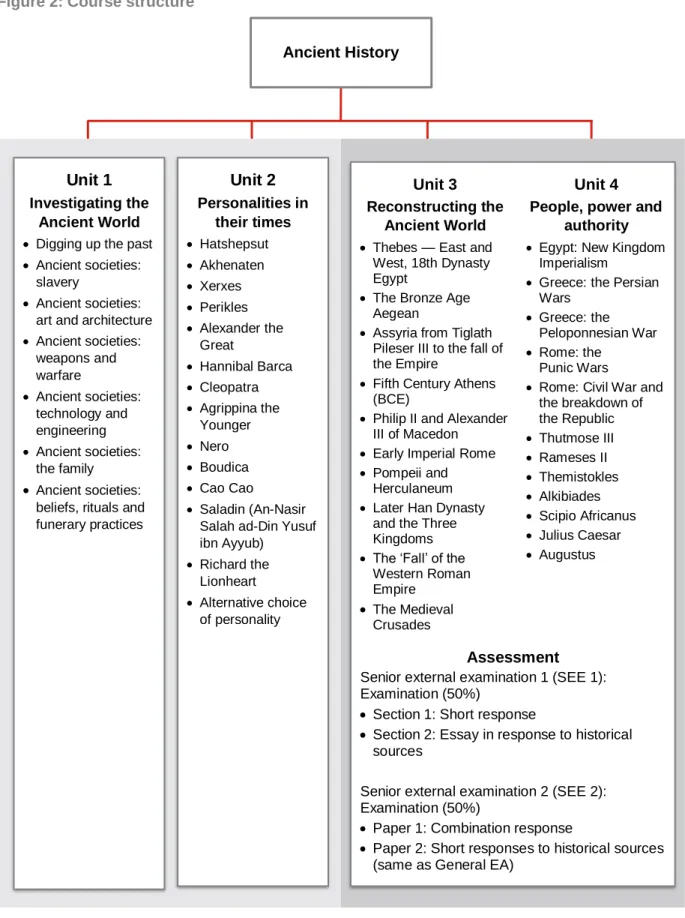Rationale
Ancient History is a general subject suitable for graduates interested in pathways beyond school leading to further study, vocational training or work. A course in Ancient History can create a basis for further education and employment in the fields of archaeology, history, education, psychology, sociology, law, business, economics, politics, journalism, media, health and social sciences, writing, academia and research. The skills developed in ancient history can be used in the graduates' everyday life - including their work - when they need to understand situations, put them in perspective, identify causes and consequences, acknowledge the views of others, develop personal values, make judgments and reflect on their decisions.
Learning area structure
Course structure
Syllabus objectives
When candidates analyze evidence from historical sources to demonstrate understanding, they identify the features which may include origin, motif, audience, perspective, context, explicit meanings and implicit meanings. When candidates synthesize evidence from historical sources to form a historical argument, they select and combine information into a coherent whole. When candidates evaluate evidence from historical sources to make judgments, they assess usefulness and reliability.
They evaluate contested views about the past to understand the provisional nature of historical knowledge. When candidates create answers that communicate meaning to fit the purpose, they present an account that integrates evidence from sources to explain the past and develop.
Underpinning factors
Ongoing systematic teaching and learning focused on the literacy knowledge and skills specific to Ancient History is essential for achievement. Candidates must learn and use knowledge and skills of reading, watching and listening to understand and learn the content of Ancient History. These aspects of literacy knowledge and skills are embedded in the syllabus objectives, unit objectives and subject matter for Ancient History.
These aspects of numeracy knowledge and skills are embedded in the syllabus objectives, unit objectives and the Ancient History curriculum. These elements of 21st century skills are embedded in the syllabus objectives, unit objectives and the Ancient History curriculum.
Aboriginal perspectives and Torres Strait Islander perspectives
Pedagogical and conceptual frameworks
Teacher provides candidates with an issue, problem or question and an outline to address it. The inquiry components are structured and each component can be the focus of class activities, either in isolation or through connections structured by the teacher. Teacher provides questions to stimulate inquiry, and candidates are self-directed in terms of exploring these questions.
Teacher relinquishes control and candidates work more independently to formulate their own questions and problems, progressing through the full inquiry cycle, with the teacher monitoring this progress. Classroom learning can involve activities and experiences that focus on specific components of the inquiry process so that they are explicitly taught - candidates do not need to.

Subject matter
Formative assessments — Units 1 and 2
Summative assessments — Units 3 and 4
The candidate demonstrates evaluation of evidence from historical sources to make effective judgments that are reasoned and confirmed. The candidate analyzes evidence from historical sources to demonstrate understanding by identifying, examining and explaining features of evidence. The candidate demonstrates evaluation of evidence from historical sources to make appropriate judgments that are appropriate and corroborated.
The candidate identifies and examines evidence from historical sources to demonstrate a partial understanding of the characteristics of the evidence. The candidate identifies evidence from historical sources to demonstrate a superficial understanding of the characteristics of evidence.
Digging up the past
Unit objectives are drawn from the syllabus objectives and are contextualised for the subject material and requirements of the unit.
Slavery
Art and architecture
Weapons and warfare
Technology and engineering
The family
Beliefs, rituals and funerary practices
In Unit 2, candidates examine key figures of the Ancient World in the context of their time. Candidates examine the social, political and economic institutions in which the personality is positioned and focus on an analysis and evaluation of the different ways in which they have been interpreted and represented from ancient to modern times. Candidates consider the characteristics that characterize a significant ancient personality and the driving forces behind such individuals.
In this unit there is a focus on the key conceptual understandings of: context, reliability and usefulness of sources; perspectives and representation; proof; continuity and change; cause and effect; importance; empathy; and competitiveness. The subject provides the context through which the historical concepts, skills, knowledge and understandings described in the unitary objectives are developed.
Hatshepsut
Akhenaten
Xerxes
Perikles
Alexander the Great
Hannibal Barca
Cleopatra
Agrippina the Younger
Nero
Boudica
Cao Cao
Saladin (An-Nasir Salah ad-Din Yusuf ibn Ayyub)
Richard the Lionheart
Alternative choice of personality
In Unit 3, candidates investigate significant historical periods through an analysis of relevant archaeological and written sources. Candidates examine how these sources have been used to construct an understanding of relevant social, political, religious and economic institutions and practices, key events and individuals in a historical period. This unit allows for greater focus on historiography and challenges associated with an interrogation of evidence.
Candidates analyze the usefulness of a wide range of sources and the contribution of research and science to the reconstruction of a historical period. Note: QCAA will nominate one topic from the list below which will be the basis for Section 1 of Senior external examination 1 (SEE 1). QCAA will nominate a subject other than the list below which will be the basis for Section 2 of Senior external examination 1 (SEE 1).
The sequence and emphasis of these objectives should be applied to enhance and align with the process of historical research.
Thebes — East and West, 18th Dynasty Egypt
The Bronze Age Aegean
Assyria from Tiglath Pileser III to the fall of the Empire
Fifth Century Athens (BCE)
Philip II and Alexander III of Macedon
Early Imperial Rome
Pompeii and Herculaneum
Later Han Dynasty and the Three Kingdoms
The ‘Fall’ of the Western Roman Empire
The Medieval Crusades
Senior external examination 1 (SEE 1): Examination (50%)
It assesses the application of a range of cognitions to unseen questions in response to historical sources provided in the study. Note: QCAA will nominate two topics from Unit 3, Topics 1-10, which will form the basis for SEE 1. Note: QCAA will nominate one topic from Unit 3, which will form the basis for Section 1 of Senior External Exam 1 ( SEE 1) .
The topic nominated from Unit 3 for this section will be different from that nominated for Section 2. The nominated topic and the candidate's chosen area reflect the application of key questions raised in the in-depth study. Context statements will be provided for each source in the form of a brief description which may include author, time of production and any general details of the circumstances under which a source was produced.
Note: QCAA will nominate one topic from Unit 3 which will be the basis for Section 2 of Senior external examination 1 (SEE 1). The unseen question will be developed from Unit 3, using the topic from Topics 1–10 nominated by the QCAA for study. Context statements will be provided for each source in the form of a brief description which may include author, time of production and any general details about the circumstances in which a source was produced.
Note: QCAA will nominate one topic from the list below (Topics 1–5) which will be the basis for Paper 1 of Senior external examination 2 (SEE 2). Note: QCAA will also nominate one topic from the list below (Topics 6–12) which will be the basis for Paper 2 of Senior external examination 2 (SEE 2). This will be the same subject as that nominated for the Ancient History General Senior Syllabus.
Egypt — New Kingdom Imperialism
Greece — the Persian Wars
Greece — the Peloponnesian War
Rome — the Punic Wars
Rome — Civil War and the breakdown of the Republic
Thutmose III
Rameses II
Themistokles
Alkibiades
Scipio Africanus
Julius Caesar
Augustus
Senior external examination 2 (SEE 2): Examination (50%)
Queensland Curriculum & Assessment Authority March 2020 Page 75 of 97. a subject whose primary pathway is work and vocational education; emphasizes applied learning and community connections; a subject for which a syllabus has been developed by QCAA with the following characteristics: results from courses developed from applied syllabuses contribute to QCE; results can contribute to ATAR calculations. use knowledge and understanding in response to a given situation or circumstance; to perform or use a procedure in a given or particular situation. value estimate the value, importance or status of something; judge or consider a text or work. appraise know or make a judgment about the worth or value of something; fully understand; understand the full acceptable appropriate implications; fit or suitable for a particular purpose,. suitable for the purpose or occasion; convenient, convenient. archeology the study of human history and prehistory through the excavation of sites and the analysis of physical remains. field of study a division of, or a section within a unit. argue give reasons for or against something; challenge or debate an issue or idea; to convince, prove, or attempt to prove by giving reason object of a man-made artifact, typically cultural, social, and historical. aspects a particular part of a feature of something; an aspect, phase or part of a whole. measure, determine, assess, rate, or make a judgment about the value, quality, results, outcomes, size, importance, nature, or extent of something. assessment the deliberate and systematic collection of information about the achievements of candidates. assessment instrument a tool or device used to gather information about a candidate's achievements. drawn from the unit objectives and contextualized to the requirements of the assessment instrument. see also 'curriculum objectives', 'unit objectives'). Harvard referencing style; and the Modern Language Association of America (MLA) referencing style. reconstruction process of gathering evidence from sources to develop an understanding or explanation of the past. reference list a list of works cited in the final product submitted for evaluation, using a known refined referencing system developed or improved to be accurate, precise or subtle. Where does it come from? repetitive containing or characterized by repetition, especially when it is unnecessary or tedious. reporting that provides information summarizing the candidate's performance at various times throughout a course of study, representing a picture or image of the past that may be a portrayal within society. past or present) or that can be created by historians.
Unseen sources are a prompt that candidates receive at the beginning of an essay in response to historical sources. Meaning involves examining the principles behind the choice of what to research and remember, and involves addressing questions such as: How people in the past viewed the meaning of an event. Staver, JR & Bay, M 1987, 'An analysis of project synthesis goal group orientation and research emphasis of elementary science textbooks', Journal of Research in Science Teaching, vol.

